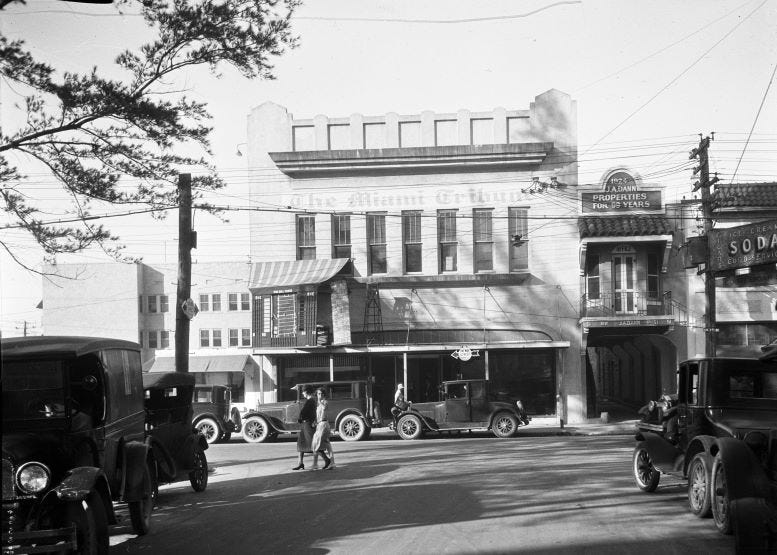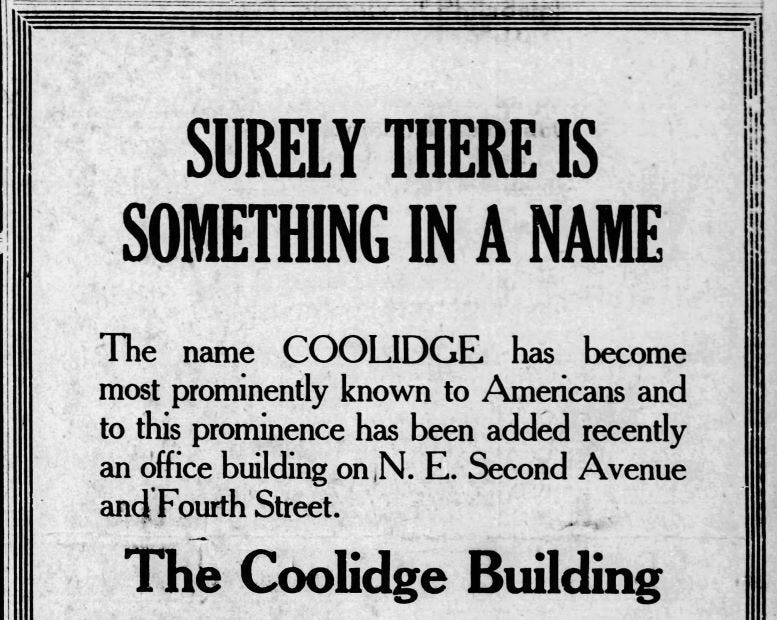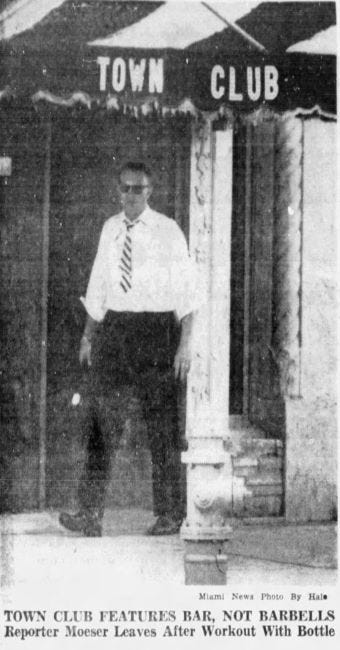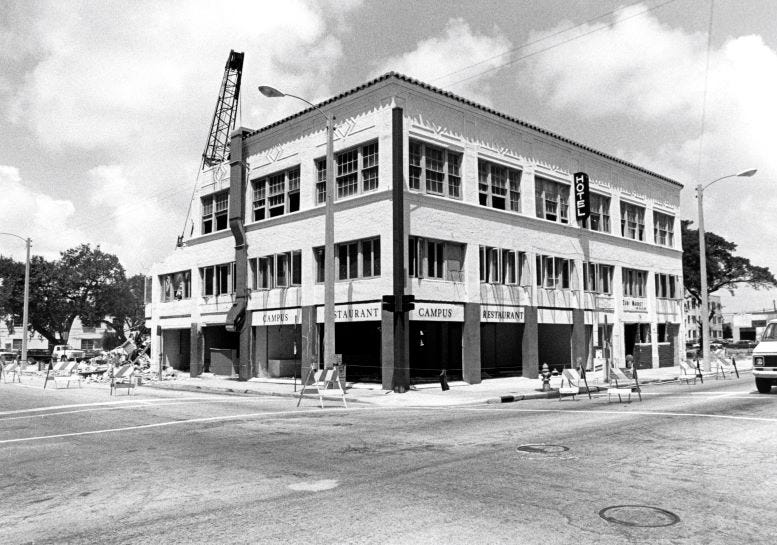Coolidge Building in Downtown Miami
During the peak of the building boom of the 1920s, demand for residential housing, hotels, and commercial office space was far exceeding the supply. Real estate firms were being formed almost daily by the onset of 1924, which put even more demand for office space for realtors and brokers who preferred to conduct business in the epicenter of the boom in downtown Miami.
One of the structures to help mitigate the shortage of commercial office space was the Coolidge Building at 404 N.E. Second Avenue. What was once the site for the residence of a prominent pioneer blacksmith became a hub of real estate activity during a formative period in Miami’s history. This article will share the story of the Coolidge Building which opened in May of 1925, during the peak year of the 1920s building boom, and stood until September of 1979, when it was razed to make room for Building 2 in the downtown campus of Miami-Dade College.
Residence of J.A. Dann ‘The Wagon Man’
From the early 1900s until 1914, the northwest corner of NE Second Avenue and NE Fourth Street was the residence of the pioneer Dann family. The patriarch of the family, James A. Dann arrived in Miami on April 12, 1899, from Kissimmee, Florida, and promptly opened a wagon shop and harness factory to become one of Miami’s first blacksmiths. In order to convey a memorable slogan, all of Dann’s advertisements in the local papers would feature the headline: ‘J.A. Dann – The Wagon Man’.
One of his first acts after arriving in Miami in 1899 was to purchase a lot across from where the Dade County Courthouse was later built. This parcel of land would become the location of Dann’s real estate office after he sold his blacksmith shop in 1920, as well as the location of the Miami Tribune in 1924 when they leased the building to the west of Dann’s office. The address of the J.A. Dann Properties office building was 51 NW First Street.
Dann and his family constructed their first home on the corner of Avenue B and Eighth Street (today’s NE Second Avenue and NE Fourth Street), in the early 1900s, which would give way to the Coolidge building in 1925. In February of 1914, Dann agreed to trade his lot and residence to the Methodist Church – South, for two lots that the church owned two blocks north of his property. By the early 1920s, the Dann family constructed an estate on a five-acre tract of land and moved to 1389 NW 7th Street to the east of the Grove Park subdivision along the Miami River. This residence would later be included as one of several buildings for the Rivermont Park Manors retirement facility for the elderly.
By 1919, the church sold the property at the 400-block of Avenue B (N.E. Second Avenue), and it was rezoned for commercial use. The land was sold three more times in 1920, but nothing was built on the parcel until 1924 when the demand for office space led to the construction of a commercial building which would become the home of several real estate firms during the peak of the building boom.
Building Named for the President
When President Warren Harding died unexpectedly on August 2, 1923, of a heart attack in San Francisco on a speaking tour of western states, Vice President Calvin Coolidge was sworn as President of the United States the next day. During the mid-1920s, Coolidge was highly regarded which was reflected in the number of buildings and institutions named for him during this time.
When a new three-story building was constructed in 1924 - 25 at the corner of NE Second Avenue and NE Fourth Street it was named for the president. The ads published in the local newspapers to announce the opening of the building proudly conveyed the importance of the name of the edifice. Below is an advertisement published in the Miami Herald on May 23, 1925:
Given the fever pace of the buying and selling of real estate in May of 1925, it is no surprise that the building was almost completely occupied by real estate brokers and agents. The largest tenant was the firm of C. Dan Wallace which had a number of separate legal entities representing projects such as Wallace Park, Webster Terrace, Commercial Silver Bluff, Ocean View Heights, Gratigny Plateau, and Grapeland Boulevard Company.
In addition to the real estate firms, the Westinghouse Electric Company opened their Miami sales office in the building on June 1, 1925. In 1927, the prominent firm of W.E. Brown Engineering Company was added as a tenant in the Coolidge building. However, by that time the real estate bubble had burst, and many of the realty firms that had leased office space in the building when it opened had gone out of business within a year after the devastating hurricane of 1926.
While the building was primarily configured with individual offices, it also featured an auditorium for meetings and small conventions. In February of 1929, Arthur O. Wharton, president of the International Association of Machinists, addressed a packed auditorium of machinists and automobile mechanics in the hall. The auditorium was put to good use when an art school took over the building in the early 1930s.
School of Applied Arts
During the early years of the Great Depression many of the commercial buildings in Miami were largely vacant as the economy worsened. Some of the buildings were converted into hotels, and others were adaptively reconfigured for other purposes. Such was the case with the Coolidge Building when the School of Applied Arts took over the edifice in 1932. The meeting hall became known as the Applied Arts Hall and many recitals, reunions, and other performances were conducted in the auditorium.
The Miami School of Applied Arts was founded in 1926 by Mrs. Jean Littlewood. Departments included tutoring and coaching of students with learning disabilities in the third through six grades. In addition, courses in languages, higher arithmetic, expression, dramatics, health culture, psychology, and music were also offered by the school.
The school operated out of the Coolidge Building until they moved to a new location at 127 NE First Avenue in 1938. The academy would move again in 1946 to 34 West Flagler Street from where it operated into the 1950s.
Air Express International
After the art school had vacated the Coolidge Building, Air Express International (AEI), looking for more office space, leased most of the Coolidge Building in October of 1942. The firm was an air freight shipping company that outgrew its old quarters in the Postal Building. The Miami subsidiary was started in 1939 by Chester M Mayer, who founded the parent company in New York in 1935.
Air Express International (AEI), was conceived when Mayer noticed that Pan American was having trouble expediting and tracking their freight business. He created AEI to help Pan American manage their air freight business and then expanded these services to other airlines. During World War II, AEI contracted with the military to help facilitate the transport of supplies and freight throughout the different theaters of war. This experience helped fuel the expansion of the company during the post-war years.
After completely remodeling the first two floors of the building, Air Express International was able to triple its office space in the Coolidge Building compared to what they had in the Postal Building. The address for the reconfiguration was 408-10 NE Second Avenue. Given the importance of proximity to the airlines they supported, the company would eventually relocate closer to the Miami International Airport at 6600 NW 36th Street shortly after the conclusion of the war.
Coolidge Hotel & Military Recruiting Offices
By 1945, ads began appearing in the local newspapers for the Coolidge Hotel at 406 NE Second Avenue. After Air Express International began transitioning to their new location near the airport, the Coolidge Building was once again reconfigured, but this time to accommodate an inexpensive inn. The hotel operated out of the second and third floors of the building while the ground level office space was leased for commercial retail establishments.
In 1953, it was announced that the United States Navy and Marines recruiting offices were being moved into the Coolidge Building from the U.S. Courthouse federal building on NE First Avenue. The reason for the move from the federal building was that the U.S. District Attorney’s office was being moved from Jacksonville to the federal building in Miami, which would take over the office space occupied by the recruiting agencies, leaving them to find office space in a different building. The address given for the recruiting offices was 410 NE Second Avenue, which was formerly the address of Air Express International.
Town Athletic Club
By the late 1950s, South Florida began to see a rise in the number of private ‘drinking clubs,’ particularly in downtown Miami. During this period, the annual license fee for a regular bar owner would be $1,500, whereas a private club owner would only incur a $250 annual fee. In addition, legitimate bar owners would be subject to much tighter regulation and two fewer hours of operation than the private clubs, which incentivized new proprietors to file for a liquor license as a private club rather than a legitimate tavern.
The only requirement of the private club licensing approach is that the primary purpose of the club should be something other than drinking establishment, and that dues by the members of the club must be paid up front. By the late 1950s, the city of Miami’s Beverage Department was responsible for overseeing 3,600 licenses, which made it impractical to properly enforce the different types of licenses.
The Town Athletic Club at 402 NE Second Avenue in the Coolidge Building was one of these establishments. While the unofficial purpose of this establishment was a fitness club, it was nothing more than a typical downtown bar. This was exposed during an investigative report published in the Miami News on May 22, 1958. A reporter posed as a prospective member of the Town Athletic Club and found out that the establishment did not require a formal membership, upfront payment, and did not offer anything athletic beyond lifting a beer bottle from the bar to a patron’s mouth for consumption.
While the article shed light on the scheme to acquire an inexpensive liquor license, it was not until 1961 that the county stepped in to enforce the state’s liquor laws. The Dade County attorney, Darrey Davis, began a crackdown to end the private club liquor license loophole. Although it is not clear how much longer the Town Athletic Club lasted in the Coolidge building, its days as a hybrid tavern and ‘faux health club’ were in its final days by the early 1960s.
Campus Restaurant & Demolition
By the late 1960s, there were plans being made to redevelop part of downtown Miami for Dade County Junior College’s main campus. The block south of the Coolidge building was the focus of the redevelopment effort for the first edifice, which we know today as Building One for Miami-Dade College’s Wolfson, or downtown, campus. By the early-1970s, the Coolidge Hotel was still operating as an inexpensive flophouse, but the ground level of the building where the Town Athletic Club formerly operated was converted into the Campus Restaurant to serve the college students who attended classes in the downtown campus’ lone building.
However, the growth of the campus necessitated an expansion to a second building. Dade Junior College acquired the buildings located on the 400-block on N.E. Second Avenue to begin construction of a second building to support the increase of the school’s enrollment. By the fall of 1979, the clearing of the block to prepare for construction of the second college building began. One of the first buildings to be razed was the Coolidge Building, which was cleared by the end of September of that year.
Today, Building Two for Miami-Dade College sits on the corner where the Coolidge Building once resided. The college added several other structures through the years and has expanded its footprint along N.E. Second Avenue rather dramatically. There are five main buildings serving the Wolfson campus for the college. Building Two occupies the 400-block of N.E. Second Avenue, bracketed by N.E. First Avenue to the west, along with the Harry Cain Tower and City of Miami Fire Station One.
The street between Building One and Building Two of the campus, N.E. Fourth Street, was closed between N.E. Second Avenue and N.E. First Avenue provides a pedestrian promenade for students. The campus is the host venue for the Miami Book Fair and countless other activities in downtown Miami. What was once an assortment of early Twentieth Century buildings more than fifty years ago has been transformed into the main campus of an institution that claims one of the largest undergraduate enrollments in the county. As of the 2022 school year, there are 47,245 undergraduate enrollees at the college across all of the school’s campuses according to U.S. News and World Report.
Resources:
Miami Herald: “Surely There is Something in a Name”, May 20, 1925.
Miami Herald: “Westinghouse To Open Sales Office”, May 22, 1925.
Miami Herald Ad: “W.E. Brown Engineering Co.”, November 14, 1927.
Miami Daily News: “Miamians To Hear Machinists Head”, February 21, 1929.
Miami Daily News: “Professional Building Given New Face After Remodeling”, September 5, 1937.
Miami Daily News: “Air Express Firm Has New Location”, October 18, 1942.
Miami Daily News: “Recruiting HQ Moved”, September 19, 1953.
Miami Daily News: “Drinking Clubs Face Crackdown”, May 22, 1958.
Miami Herald: “Legal Aide Raps Law Evasion”, August 9, 1961.
Website: “US News & World Report”
Images:
Cover: Coolidge Building on April 11, 1979. Courtesy of Florida State Archives.
Figure 1: Office of James A Dann at 51 NW First Street in downtown Miami. Courtesy of Alamy.
Figure 2: Ad announcing the Coolidge Building in the Miami Herald on May 23, 1925. Courtesy of Miami Herald.
Figure 3: Ad for School of Applied Arts in the Miami Herald on January 7, 1934. Courtesy of Miami Herald.
Figure 4: Ad for Coolidge Hotel in the Miami Herald on March 29, 1945. Courtesy of Miami Herald.
Figure 5: Town Athletic Club in the Miami Daily News on May 22, 1958. Courtesy of Miami News.
Figure 6: Demolition of Coolidge Building on September 6, 1979. Courtesy of Florida State Archives.
Figure 7: Demolition of Coolidge Building on September 6, 1979, looking east from NE Fourth Street. Courtesy of Florida State Archives.
Figure 8: Miami Dade College Building Two on December 15, 2023. Courtesy of Casey M. Piket.












